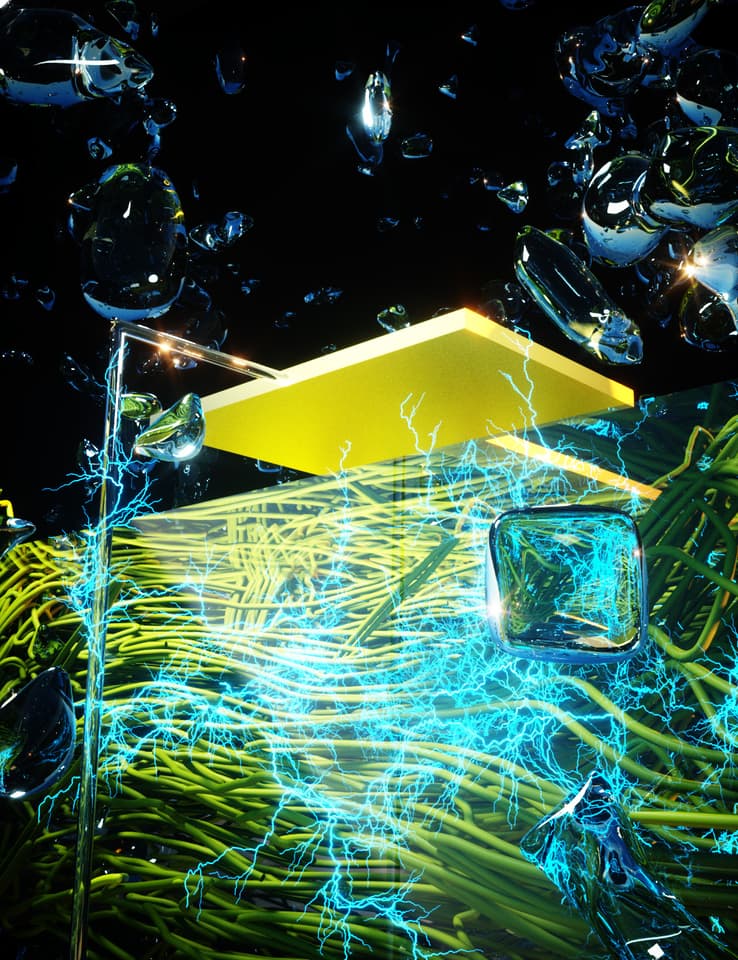As anyone who’s ever witnessed a bolt of lightning streaking through the sky knows, the air around us can be filled with an astonishing amount of energy. A new study shows that some of this energy can be harvested using a simple perforated nanofilm that can be made from an astonishing variety of materials.
In 2020, Jun Yao, assistant professor of electrical and computer engineering at UMass Amherst, and his colleagues grew nanowires from bacteria known as Geobacter sulfurreducens. The scientists showed how those wires could continuously pull electricity out of the air by harvesting even small amounts of humidity. The system relied on the chemistry of the nanowires and the pores in a film that encased them.
Building on that research, Yao and his team have now discovered that the type of nanowire involved in the process is inconsequential. The real trick, they say, has everything to do with the size of the pores in the film.
“What we realized after making the Geobacter discovery,” says Yao, “is that the ability to generate electricity from the air – what we then called the ‘Air-gen effect’ – turns out to be generic: literally any kind of material can harvest electricity from air, as long as it has a certain property.”
The property he is referring to has to do with what’s known as the “mean free path,” the distance one molecule of any substance can move before bumping into another molecule. For water, such as that which forms the humidity in the air, the distance is 100 nanometers (nm), or less than a thousandth of the width of a human hair.
As with the previous research, the new study involves two layers of nanofilm. The top has perforations smaller than 100 nm. This acts as a kind of sieve that holds water molecules on the surface as they wait to squeeze through the pores. As these molecules gather on the top film they generate a natural electrical charge that is greater than the charge on the lower layer of the film. The imbalance between the two layers effectively creates an electrical current, similar to the way in which lightning forms in clouds.
“The air contains an enormous amount of electricity,” says Yao, who is the new paper’s senior author. “Think of a cloud, which is nothing more than a mass of water droplets. Each of those droplets contains a charge, and when conditions are right, the cloud can produce a lightning bolt – but we don’t know how to reliably capture electricity from lightning. What we’ve done is to create a human-built, small-scale cloud that produces electricity for us predictably and continuously so that we can harvest it.”

Derek Lovley/Ella Maru Studio
Yao says that because the electricity-generating effect is based solely on pore size, the system could be made out of a range of different materials.
“The idea is simple but it’s never been discovered before, and it opens all kinds of possibilities,” he said. “The harvester could be designed from literally all kinds of material, offering broad choices for cost-effective and environment-adaptable fabrications. You could imagine harvesters made of one kind of material for rainforest environments, and another for more arid regions.”
While the harvesting system relies on moisture in the air to operate, as the team’s previous research showed, it doesn’t need an abundance of humidity and could theoretically even operate in desert conditions.
This isn’t the first time we’ve seen research aimed at harvesting electricity out of thin air. Last year, an Australian company named Strategic Energy saw its stock jump after it announced its “Energy Ink” technology, which relies on ambient moisture – such as the sweat produced by the human body – to generate electricity. And before that, scientists at Tel Aviv University used storm clouds as inspiration and created voltage using atmospheric water vapor and metal surfaces.
Still, if the UMass Amherst study leads to practical applications, it could be a significant step forward in this arena based on its sheer simplicity. Plus, the team says that because the nanofilm is so tiny, stacking it would be simple and could lead to power generation on the kilowatt level.
The research has been published in the journal, Advanced Materials.
Source: UMass Amherst
Source of Article